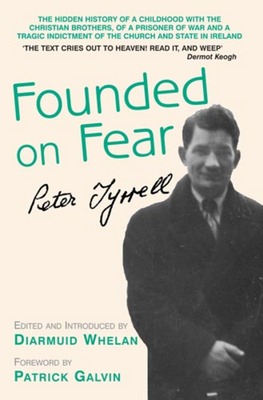Founded on Fear
Ian McKeane reviews Founded on Fear by Peter Tyrrell (Diarmuid Whelan ed.), Irish Academic Press, ISBN 071653403 7, €18.50 pbk

THIS BOOK was launched recently at the National Library in Dublin's Kildare Street. The surroundings of the launch belied the poverty and pain of the author's life which he chronicles in this memoir.
Peter Tyrrell was born in 1916, one of the generation of the new Ireland, sought and fought for at that time. He was sent to the Letterfrack Industrial School, in 1924 at the age of eight. There he and his brothers were 'cared for' and 'educated' by the Christian Brothers, an enduring process of psychological and physical abuse which he chronicles in his searingly limpid text.
His story continues beyond his time at Letterfrack and covers his time as a tailor in Ballinasloe and then his attempt to reinvent himself by going to London in 1935. His bewilderment on arriving there and his relief at being able to join the British Army is clearly described.
Tyrrell recounts his years in the Army. In India he realises that he is treating Indians badly and beginning to identifying himself with the Christian Brothers. However, it is the section of the book which deals with his time towards the end of the War as a POW in Germany when he was treated reasonably by his captors and when his food ration compared favourably with what he used to get at Letterfrack which gives a context to his experience.
Returning to England he re-entered the London community of Irish working men. His anti-clerical and outspoken views of Irish society in the 1940s gained him few friends but he did meet Owen Sheehy Skeffington, a critic of Irish educational methods and corporal punishment. Sheehy Skeffington encouraged Tyrrell to write his memoir. Publication was always an objective but was constantly frustrated because of a general refusal to accept the degree of abuse that Tyrell described. The Christian Brothers saw him as a potential blackmailer and rebuffed his approaches.
Tyrrell sank into depression and eventually his charred body was found on Hampstead Heath in 1967. It was only identified a year later by means of a burnt piece of letter to Owen Sheehy Skeffington found on it.
This is not a comprehensive blast against all the Brothers at Letterfrack. Abuse, violence and greed are clearly described and those responsible identified. Others who displayed kindness and humanity are also identified. It is, though, an indictment of a system and the damage that it inflicted on the most vulnerable children of the state.
All credit to those who have worked so hard to bring this account to us and have ensured that a remarkable man will not be forgotten.
Connolly Association, c/o RMT, Unity House, 39 Chalton Street, London, NW1 1JD
Copyright © 2006 Ian McKeane

